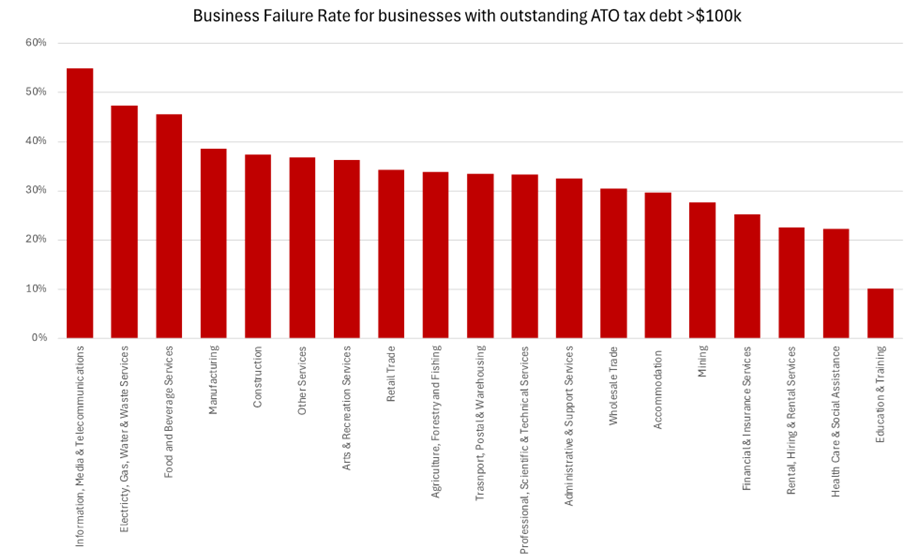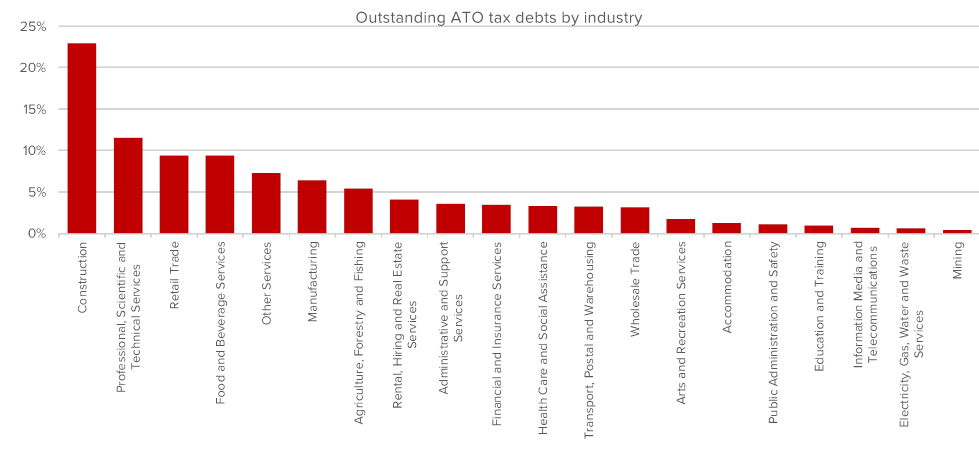SMEs need to downsize or lift profit margins to survive, says broker

Thousands of businesses are closing down because they are unable to pay massive tax debts, according to the latest data from CreditorWatch.
The credit reporting bureau revealed that thousands of private Australian businesses have failed in the past six months after defaulting on tax debts.
CreditorWatch holds 27,194 ATO tax debt default records, as at July 31, 2024, and 19,439 of these are from private companies. The ATO classifies tax debt defaults as debts with the tax office that add up to more than $100,000 and are over 90 days late.
The data shows that 34% of these private businesses, 7,003 in total, have become insolvent or voluntarily closed in the six months that CreditorWatch has been tracking the data.
Award-winning broker Kevin Wheatley (pictured above left), an excellence awardee in the 2024 Australian Mortgage Awards La Trobe Financial Broker of the Year – Commercial, and the managing director of Bayside Residential and Commercial Mortgages, said the tax debt problem was escalating and he had seen clients facing increasing pressure from the ATO.
CreditorWatch said the ATO’s outstanding debt blew out during COVID-19, when it took a “hands off” approach to debt enforcement. That outstanding debt now totals approximately $52 billion, with $34bn of this figure owed by SMEs.
The ATO has been engaged in a crackdown, what it calls “firmer actions” post-COVID as it tries to reduce the size of this debt. These actions include business tax debt disclosures to credit reporting bureaus, garnishee orders and Director Penalty Notices.
Patrick Coghlan (pictured above right), CEO of CreditorWatch, said it was appropriate that the ATO ramped up its debt enforcement program with such a huge amount outstanding.
“The ATO is simply trying to collect the tax that all companies are obliged to pay,” Coghlan said.
“I truly sympathise with the situation that these businesses are in, with such a huge amount of tax owing, particularly in the current economic climate.
“A tax debt of $100k or more is a huge drag on a business, particularly SMEs, which make up the largest cohort of businesses with tax debt defaults.”

Data source: Australian Taxation Office (ATO) direct link; private companies - registered for GST and not registered for GST
Since April 2022, the ATO has been disclosing the details of business tax debts to credit reporting bureaus under the following conditions:
- debt at least $100,000 and more than 90 days late
- the business has failed to engage with the ATO – it has not responded to two attempts to reach out and a notice of disclosure
- CreditorWatch and other credit reporting bureaus are required to remove the tax debt records of a business once it engages with the ATO by paying the outstanding debt or entering into a payment plan
Tax debt problems spiral
Wheatley said tax debt was escalating due to the current poor economic environment.
“That’s abundantly clear when I read the insolvency report that comes out every morning from the Supreme Court,” said Wheatley. “When you go to the section on wind-up notices, the ATO is the biggest claimant on tax debt, so it’s a serious problem.”
There were a number of reasons why businesses were not servicing their tax debt.
Wheatley said businesses were aware they had to pay tax debts but often they were too scared to pass on increased costs to customers because they couldn’t afford to lose clients.
“It’s just a wicked business environment. Unfortunately, you’ve got to do one of two things – you either downsize the business and make it more viable, or increase your margins – there’s no other way.
“You have to increase your profit margins to improve your cash flow position, you can’t go abusing taxation money – it’s got to be paid to the taxation office.”
Wheatley said some inexperienced SMEs were falling victim to the ATO because they were opting to use tax money sitting in their bank accounts.
“I’m seeing these problems daily because when the ATO starts putting pressure on them, they’re coming to people like myself to try and release the cash out of the equity in their properties but you can only do that for so long before you run out of equity in your assets.”
Advice to SMEs
Wheatley advised businesses that had significant tax debts to increase their working capital or risk insolvency.
“You’ve got to pass on whatever your costs are … or restructure the company and weed out those that are not profitable to you and streamline your business so it becomes more manageable and you can cover your expenses.
“Taxation is one of those expenses you have to cover at all times.”
The construction sector had been hit particularly hard by tax debt, with tradies waiting up to two years to get paid, which “devastates cash flow”.
Tax debt loans are a viable option but they only offer a short-term fix, said Wheatley.
“You could also enter into payment arrangements with the ATO but I believe the interest is around 13%.”
Wheatley said the ATO is now trying to recover the government money that was used to stimulate the economy during the pandemic. “They’re taking a very hard stand now – they’ll wind you up very quickly.”
Industries hardest hit by ATO debt
CreditorWatch said ATO data showed that the information, media and telecommunications sector had experienced the highest rate of failures due to overwhelming tax debts. More than half of businesses (55%) with a tax debt over $100,000 and more than 90 days late have failed over the past six months.
Electricity, gas, water and waste services had the second highest failure rate (47%), followed by food and beverage services (465) and manufacturing (39%).

Data source: Australian Taxation Office (ATO) direct link (all companies)
CreditorWatch chief economist Anneke Thompson (pictured above centre) said that holding a large outstanding tax debt in the current economic climate would put any business in an extremely challenging situation.
“Even in good trading conditions, paying off a debt of over $100,000 is hard enough,” Thompson said.
“Combine that with retail trade that is falling on a per capita basis, very low levels of new housing starts, and continued rising utilities and insurance costs, and it is sadly not surprising that many businesses with a tax default disclosed do fail within a short period of time.”
Thompson said information, media and telecommunications had been dealing with industry upheaval for many years now, as so much news is now sourced through social media and other free channels.
“It is likely that these businesses are in a far more precarious position than the education sector, which is at the other end of the spectrum. So far, only 10 per cent of businesses in the education sector with a tax default have failed, but this is likely to increase as the international student caps kick in next year.”
Are you seeing a rise in SME customers struggling with ATO tax debts? Comment below.



